Collaborative Integrated Navigation for Unmanned Aerial Vehicle Swarms Under Multiple Uncertainties
Abstract
1. Introduction
- Uncertainty in external correction information for the swarm: This information often contains outliers, significantly affecting the localization accuracy of the leader UAVs;
- Propagation of leader UAV localization uncertainties: When the leader drones localize the follower drones, their own uncertainties are transmitted;
- Challenges in handling uncertainties due to high nonlinearity in inter-UAV distance measurements.
- To address the issue of outliers in external information, a normal gamma distribution is employed to model measurement noise. A robust filter for integrated navigation based on the normal gamma distribution (RINNG) under tight coupling is derived to model and handle uncertainties in external information, which is presented in Section 3.
- A statistical linearization model is proposed in Section 4 to further account for the uncertainty in the leader UAV’s positioning. The positioning result of the leader UAV is given by the RINNG in Section 3. This contribution focuses on achieving statistical linearization of nonlinear models for the least squares positioning in contribution 3, while considering the uncertainty of the positioning in contribution 1.
- To address the issue of inadequate information utilization due to the high nonlinearity of the model, an uncorrelated conversion method is applied to achieve least squares localization with nonlinear structures, which is given in Section 5.
2. Problem Formulation
2.1. Modeling
2.1.1. Inertial Navigation System
2.1.2. External Correction Information
2.1.3. Time Difference of Arrival Localization Information
2.2. Motivations
3. Robust Filter for Integrated Navigation Based on the Normal Gamma Distribution
3.1. Time Update
- The integration points are generated, where M is a predetermined number, usually chosen as 3 or 5. Construct a diagonal symmetric matrix D with elements on the diagonal being 0 and . Calculate the eigenvalues of the matrix D, and let the integration points with being the mth eigenvalue. Let the normalized eigenvector corresponding to be denoted as , then the weight , where is the first element of .
- Based on the estimate and its MSE , sigma points are generated, with the mth sigma point beingwhere is the result of the Cholesky decomposition of , i.e., .
- Based on the sigma points and their weights, the conditional mean isand the conditional MSE matrix iswhere the conditional scale matrix is
3.2. Measurement Update
4. Statistical Linearization for Nonlinear Systems Considering Multiple Uncertainties
- The function is continuously differentiable and can be sufficiently approximated by a first-order Taylor series expansion in the neighborhood of a given point.
- The first two moments of and are equal.

5. Augmented Nonlinear Least Squares Estimation for Collaborative Positioning Among UAVs
5.1. First Step
5.2. Second Step
6. Simulation
6.1. Scenario 1: Positioning Using Outlier Corrupted External Correction Measurements
6.2. Scenario 2: Mutual Positioning Using TDOA Measurements
6.3. Scenario 3: UAV Swarm Collaborative Positioning
7. Conclusions
Author Contributions
Funding
Institutional Review Board Statement
Informed Consent Statement
Data Availability Statement
Conflicts of Interest
Abbreviations
| UAV | unmanned aerial vehicle |
| GNSS | global navigation satellite system |
| NLOS | non-line-of-sight |
| INS | inertial navigation system |
| SLAM | simultaneous localization and mapping |
| UWB | ultra wide band |
| probability density function | |
| TDOA | time difference of arrival |
| TWLS | two-step weighted least squares |
| RINNG | robut integrated navigation based on normal gamma distribution |
| RMSE | root mean square error |
| UKF | unscented Kalman filter |
| ANLS | augmented nonlinear least squares |
References
- Tahir, A.; Boing, J.; Haghbayan, M.H.; Toivonen, H.T.; Plosila, J. Swarms of Unmanned Aerial Vehicles—A Survey. J. Ind. Inf. Integr. 2019, 16, 142–149. [Google Scholar] [CrossRef]
- Sun, L.; Zhang, J.; Yang, Z.; Fan, B. A motion-aware siamese framework for unmanned aerial vehicle tracking. Drones 2023, 7, 153. [Google Scholar] [CrossRef]
- Li, Z.; Jiang, C.; Gu, X.; Xu, Y.; Cui, J. Collaborative positioning for swarms: A brief survey of vision, LiDAR and wireless sensors based methods. Def. Technol. 2024, 33, 475–493. [Google Scholar] [CrossRef]
- Elamin, A.; Abdelaziz, N.; El-Rabbany, A. A GNSS/INS/LiDAR integration scheme for UAV-based navigation in GNSS-challenging environments. Sensors 2022, 22, 9908. [Google Scholar] [CrossRef]
- Mostafa, M.; Zahran, S.; Moussa, A.; El-Sheimy, N.; Sesay, A. Radar and visual odometry integrated system aided navigation for UAVS in GNSS denied environment. Sensors 2018, 18, 2776. [Google Scholar] [CrossRef]
- Lee, J.C.; Chen, C.C.; Shen, C.T.; Lai, Y.C. Landmark-based scale estimation and correction of visual inertial odometry for vtol uavs in a gps-denied environment. Sensors 2022, 22, 9654. [Google Scholar] [CrossRef]
- Negru, S.A.; Geragersian, P.; Petrunin, I.; Guo, W. Resilient Multi-Sensor UAV Navigation with a Hybrid Federated Fusion Architecture. Sensors 2024, 24, 981. [Google Scholar] [CrossRef]
- Tavares, A.J., Jr.; Oliveira, N.M. A Novel Approach for Kalman Filter Tuning for Direct and Indirect Inertial Navigation System/Global Navigation Satellite System Integration. Sensors 2024, 24, 7331. [Google Scholar] [CrossRef]
- Konovalenko, I.; Kuznetsova, E.; Miller, A.; Miller, B.; Popov, A.; Shepelev, D.; Stepanyan, K. New approaches to the integration of navigation systems for autonomous unmanned vehicles (UAV). Sensors 2018, 18, 3010. [Google Scholar] [CrossRef]
- Zhang, L.; Lan, J.; Li, X.R. A normal-Gamma filter for linear systems with heavy-tailed measurement noise. In Proceedings of the 21th International Conference on Information Fusion, Cambridge, UK, 10 July–13 July 2018; pp. 2548–2555. [Google Scholar]
- Qi, Y.; Zhong, Y.; Shi, Z. Cooperative 3-D relative localization for UAV swarm by fusing UWB with IMU and GPS. J. Phys. Conf. Ser. 2020, 1642, 012028. [Google Scholar] [CrossRef]
- Belfadel, D.; Haessig, D.; Chibane, C. Range-Only EKF-Based Relative Navigation for UAV Swarms in GPS-Denied Zones. IEEE Access 2024, 12, 154832–154842. [Google Scholar] [CrossRef]
- Chen, H.; Xian-Bo, W.; Liu, J.; Wang, J.; Ye, W. Collaborative multiple UAVs navigation with GPS/INS/UWB jammers using sigma point belief propagation. IEEE Access 2020, 10, 193695–193707. [Google Scholar] [CrossRef]
- Chen, M.; Xiong, Z.; Song, F.; Xiong, J.; Wang, R. Cooperative navigation for low-cost UAV swarm based on sigma point belief propagation. Remote Sens. 2022, 14, 1976. [Google Scholar] [CrossRef]
- Zhu, X.; Lai, J.; Chen, S. Cooperative Location Method for Leader-Follower UAV Formation Based on Follower UAV’s Moving Vector. Sensors 2022, 22, 7125. [Google Scholar] [CrossRef] [PubMed]
- Chan, Y.T.; Ho, K.C. A simple and efficient estimator for hyperbolic location. IEEE Trans. Signal Process. 1994, 42, 1905–1915. [Google Scholar] [CrossRef]
- Sun, L.; Ji, B.; Lan, J.; He, Z.; Pu, J. Tracking of maneuvering complex extended object with coupled motion kinematics and extension dynamics using range extent measurements. Sensors 2017, 17, 2184. [Google Scholar] [CrossRef]
- Xu, Z.; Zhou, G. Long-Time Coherent integration for radar detection of maneuvering targets based on accurate range evolution model. IET Radar Sonar Navig. 2023, 17, 1558–1580. [Google Scholar] [CrossRef]
- Xu, L.; Liang, Y.; Duan, Z.; Zhou, G. Route-based dynamics modeling and tracking with application to air traffic surveillance. IEEE Trans. Intell. Transp. Syst. 2019, 21, 209–221. [Google Scholar] [CrossRef]
- Li, Q.; Lan, J.; Zhang, L.; Chen, B.; Zhu, K. Augmented nonlinear least squares estimation with applications to localization. IEEE Trans. Aerosp. Electron. Syst. 2021, 58, 1042–1054. [Google Scholar] [CrossRef]
- Zhang, L.; Lan, J.; Li, X.R. Normal-Gamma IMM filter for linear systems with non-Gaussian measurement noise. In Proceedings of the 22th International Conference on Information Fusion, Ottawa, ON, Canada, 2–5 July 2019; pp. 1–8. [Google Scholar]
- Agamennoni, G.; Nieto, J.I.; Nebot, E.M. Approximate inference in state-space models with heavy-tailed noise. IEEE Trans. Signal Process. 2012, 60, 5024–5037. [Google Scholar] [CrossRef]
- Särkkä, S.; Nummenmaa, A. Recursive noise adaptive Kalman filtering by variational Bayesian approximations. IEEE Trans. Autom. Control 2009, 54, 596–600. [Google Scholar] [CrossRef]
- Zhang, L.; Lan, J. Tracking of extended object using random matrix with non-uniformly distributed measurements. IEEE Trans. Signal Process. 2021, 69, 3812–3825. [Google Scholar] [CrossRef]
- Arasaratnam, I.; Haykin, S.; Elliott, R.J. Discrete-time nonlinear filtering algorithms using Gauss–Hermite quadrature. Proc. IEEE 2007, 95, 953–977. [Google Scholar] [CrossRef]
- Julier, S.J.; Uhlmann, J.K. Unscented filtering and nonlinear estimation. Proc. IEEE 2004, 92, 401–422. [Google Scholar] [CrossRef]
- Lan, J.; Li, X.R. Nonlinear estimation by LMMSE-based estimation with optimized uncorrelated augmentation. IEEE Trans. Signal Process. 2015, 63, 4270–4283. [Google Scholar] [CrossRef]
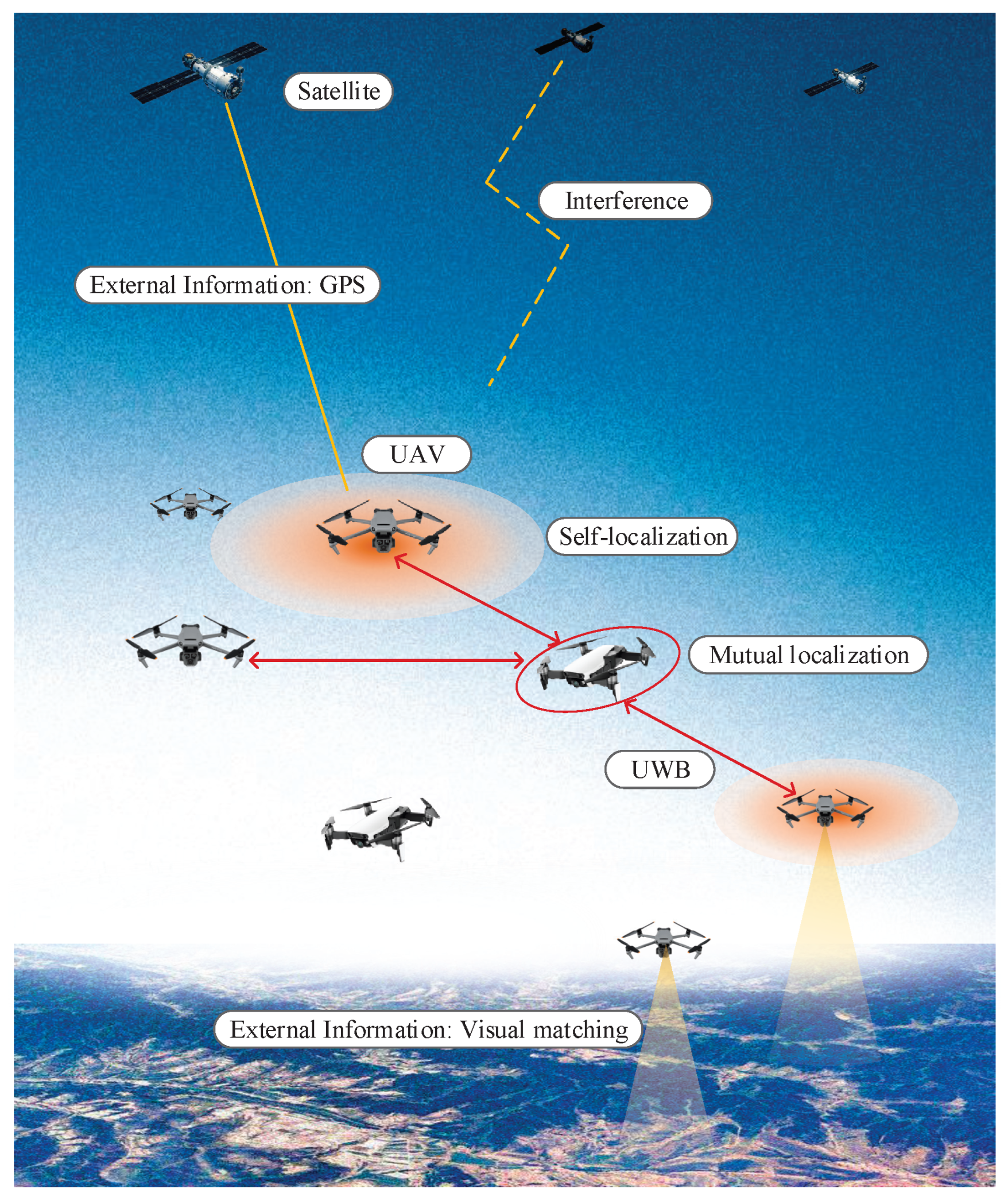

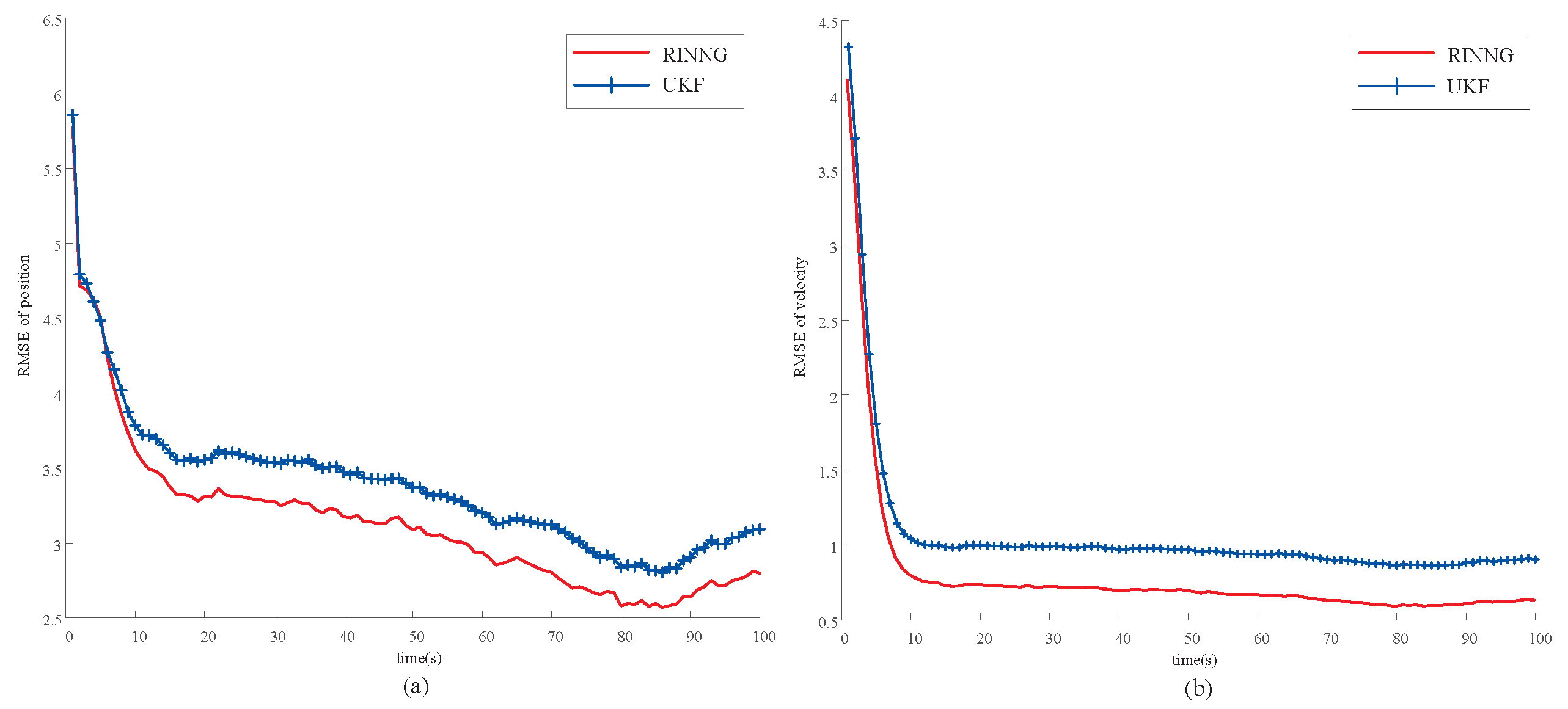
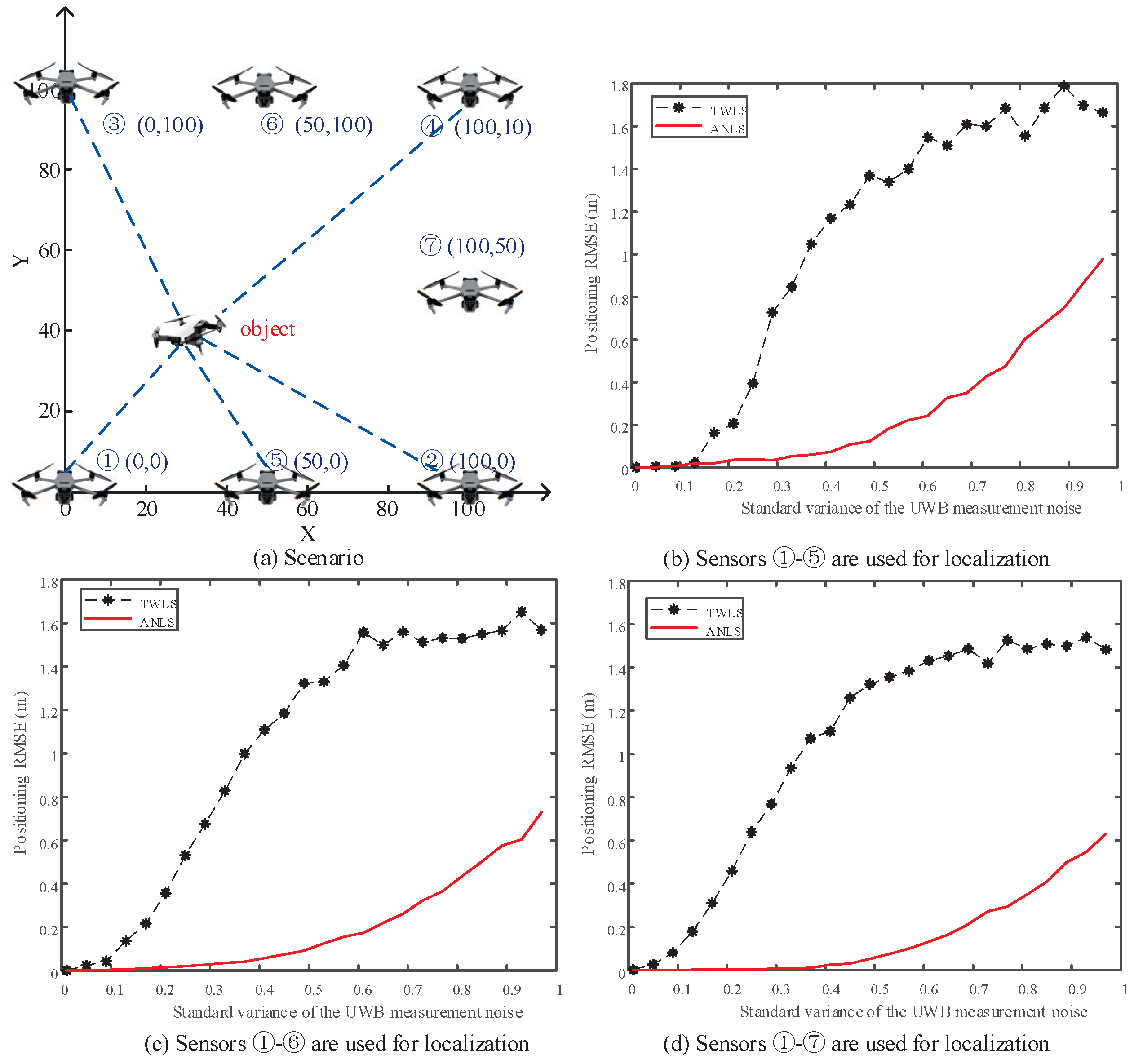
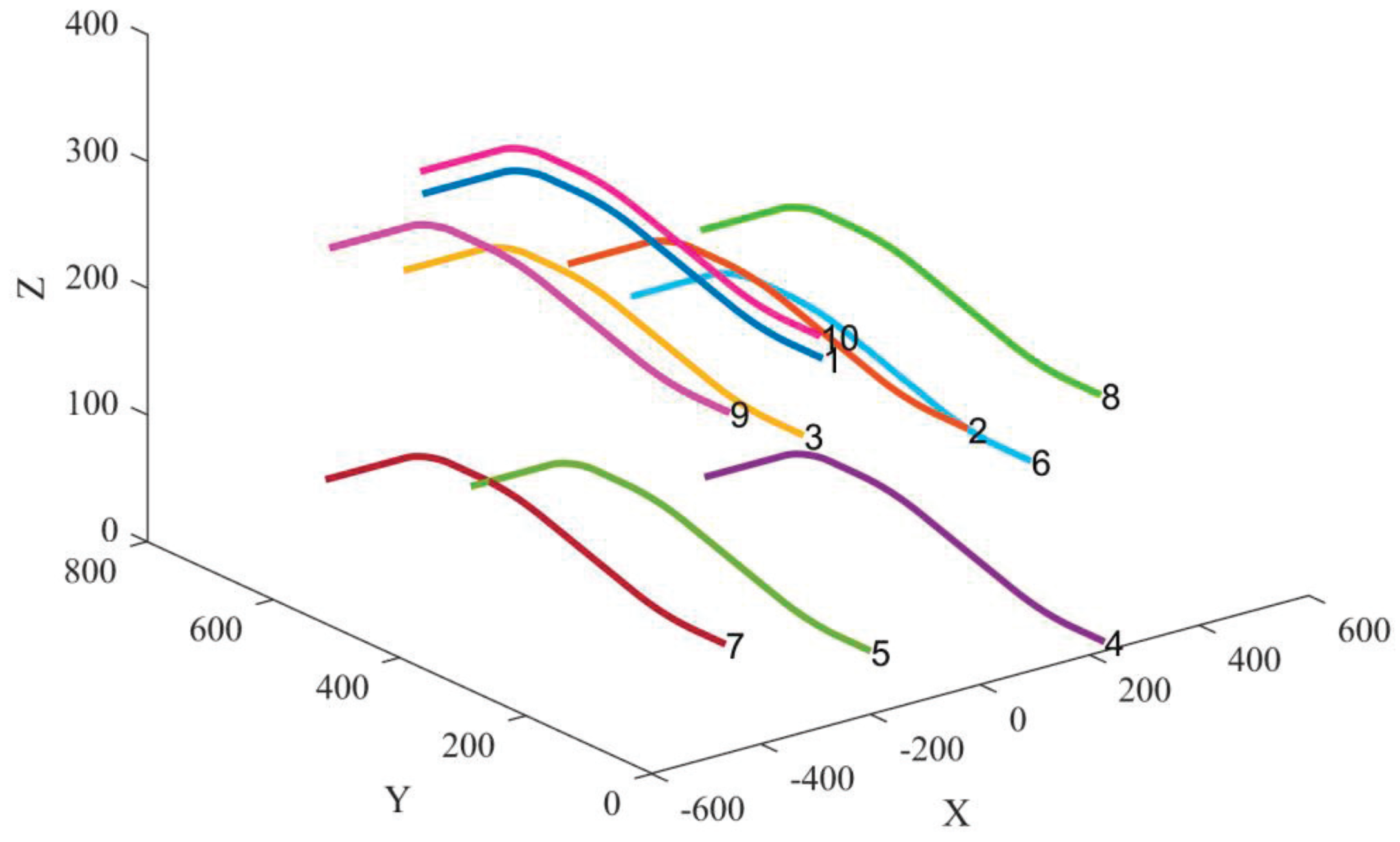
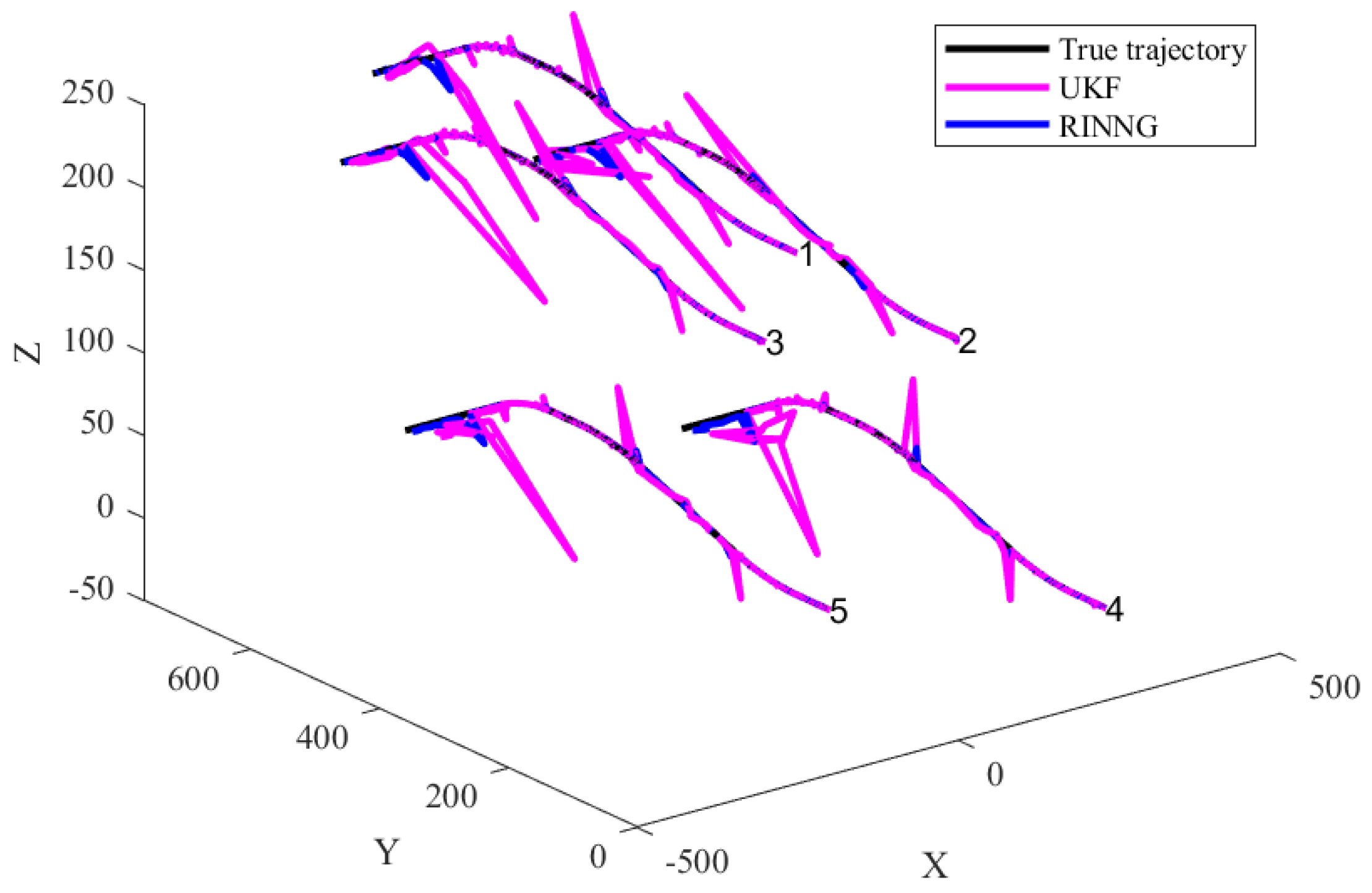


| No. | Accelerometer (g) | Gyroscope (∘/h) | ||
|---|---|---|---|---|
| Const. Drift | Rand. Drift | Const. Drift | Rand. Drift | |
| 1–5 | 10 | 100 | 1 | 1 |
| 6 | 100 | 10,000 | 10 | 10 |
| 7 | 10 | 10,000 | 10 | 10 |
| 8 | 10 | 1000 | 1 | 10 |
| 9 | 10 | 1000 | 10 | 15 |
| 10 | 100 | 1000 | 10 | 15 |
| No. | 1 | 2 | 3 | 4 | 5 |
|---|---|---|---|---|---|
| UKF | |||||
| RINNG |
| No. | 6 | 7 | 8 | 9 | 10 |
|---|---|---|---|---|---|
| UKF+UKF | |||||
| RINNG+UKF | |||||
| RINNG+ANLS |
Disclaimer/Publisher’s Note: The statements, opinions and data contained in all publications are solely those of the individual author(s) and contributor(s) and not of MDPI and/or the editor(s). MDPI and/or the editor(s) disclaim responsibility for any injury to people or property resulting from any ideas, methods, instructions or products referred to in the content. |
© 2025 by the authors. Licensee MDPI, Basel, Switzerland. This article is an open access article distributed under the terms and conditions of the Creative Commons Attribution (CC BY) license (https://creativecommons.org/licenses/by/4.0/).
Share and Cite
Zhang, L.; Cao, X.; Su, M.; Sui, Y. Collaborative Integrated Navigation for Unmanned Aerial Vehicle Swarms Under Multiple Uncertainties. Sensors 2025, 25, 617. https://doi.org/10.3390/s25030617
Zhang L, Cao X, Su M, Sui Y. Collaborative Integrated Navigation for Unmanned Aerial Vehicle Swarms Under Multiple Uncertainties. Sensors. 2025; 25(3):617. https://doi.org/10.3390/s25030617
Chicago/Turabian StyleZhang, Le, Xiaomeng Cao, Mudan Su, and Yeye Sui. 2025. "Collaborative Integrated Navigation for Unmanned Aerial Vehicle Swarms Under Multiple Uncertainties" Sensors 25, no. 3: 617. https://doi.org/10.3390/s25030617
APA StyleZhang, L., Cao, X., Su, M., & Sui, Y. (2025). Collaborative Integrated Navigation for Unmanned Aerial Vehicle Swarms Under Multiple Uncertainties. Sensors, 25(3), 617. https://doi.org/10.3390/s25030617






